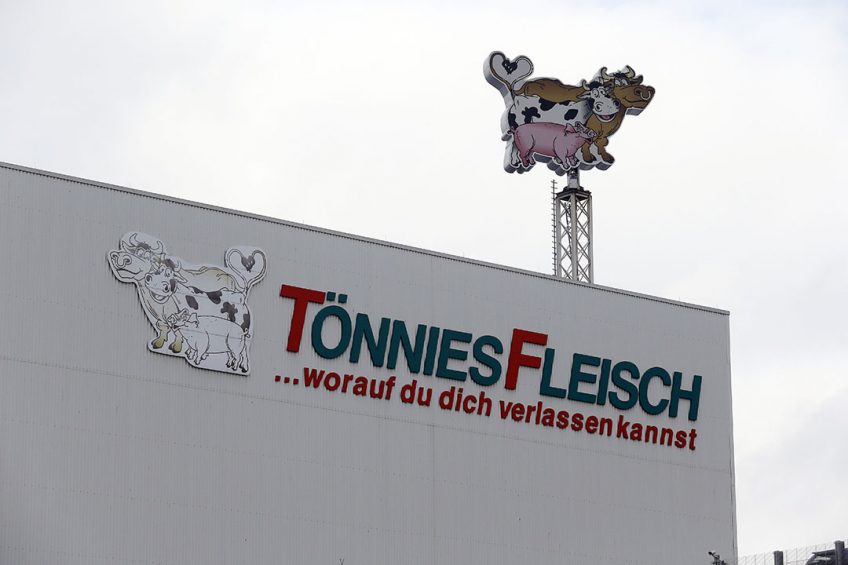Coronavirus can spread over 8m at cutting floor

Circumstances at a cutting floor can help SARS-CoV-2 spread over distances over 8 metres. That has become clear in a case study about the first wave of Covid-19 outbreaks in May, at Germany’s largest slaughterhouse, owned by Tönnies.
The study also showed that all infections during this first wave of Covid-19 outbreaks originated with just one employee. It occurred because a slaughterhouse employee got in touch with employees of an infected plant of a different packer, Westcrown, located in Dissen. Thirdly, employee housing did not play a major role in that first wave, which occurred in late May. In mid-June a second wave followed, which caused the meatpacker to close its doors for almost a month.
Those in short were the conclusions of researchers who investigated the 1st Covid-19 outbreak at the Germany’s largest pig slaughterhouse, owned by meatpacker Tönnies, which is located in Rheda-Wiedenbrück, in North Rhine Westphalia state. The research was carried out by a joint study of the Helmholtz Centre for Infection Research, the University Medical Center Clinic Hamburg-Eppendorf and the Leibniz Institute for Experimental Virology.
One single slaughterhouse employee
The study showed that the virus most likely spread from 1 single employee who was working on the cutting floor for beef. This employee indicated that together with a colleague, he had been in touch with employees of the sow cutting floor at Westcrown in Dissen, Lower Saxony. He did so after Covid-19 had been detected in that plant. The Tönnies employee did not demonstrate any clinical signs of the virus and the contact with Westcrown employees was not considered to be a high-risk contact, which is why the employee continued to show up at work. At 3 days after the meeting, the employee was tested and one day later a positive result followed, for both the employee as well as the colleague. Both then had to go into quarantine.
More employees test positive
In total, 8 days after the meeting, direct colleagues of the 2 employees’ shifts were tested, which showed that 18 more employees tested positive. All employees of that shift subsequently had to go into quarantine. Then a further 11 positive cases were discovered amongst the quarantined employees – and in the following weeks that number grew.
The study showed that 1 of the 2 colleagues who had been in touch with the Westcrown team, carried exactly the same type of virus (with the same virus sequence) as the team at Westcrown. That proved true for a large part of the Tönnies cases as well.
The researchers also zoomed in on the routes the virus took from this one employee to the other employees within Tönnies. From that research, it emerged that most colleagues within an 8m radius around the infected colleague had also tested positive. In the study it was therefore concluded that virus particles can be transmitted over longer distances under the conditions of a cutting floor.

Covid-19 Up-date
What impact is the pandemic having on the global pig sector and how are they dealing with it.
Aerosol transfer of SARS-CoV-2
Professor Adam Grundhoff, co-author of the research, said, “Our results indicate that the conditions during cutting enhance the aerosol transfer of SARS-CoV-2 particles over longer distances, think of the lower temperature, a limited input of fresh air and a constant air circulation because of the room’s airconditioning, in combination with heavy manual labour. It is very likely that these factors in general play a crucial role in outbreaks all over the world in meat or fish processing companies. Obviously, under those conditions, a distance of 1.5 to 3 metres are insufficient to prevent transmission.”
In the study, the researchers recommend additional measures are required to reduce the infection risk in those circumstances, think of e.g. improved ventilation and air flow, filtration devices or the use of high quality mouth pieces.
Exact transmission distances vary
The researchers wrote, “In addition, immediate action is required to place in quarantine all employees in a radius (around the infected person), which can be considerably larger than 2 metres. Although we have noticed transmission in an area of roughly 8 metres, it is important that exact transmission distances will vary substantially, depending on set up and company circumstances.”
Although shared apartments, bedrooms or carpooling did not play a role in the first outbreak that was studied, the researchers noted that they might have possibly played a role in a second, larger outbreak mid-June.
Closure of slaughterhouse of almost a month
The researchers also concluded that the second outbreak was caused by cases that were connected to the first outbreak. The second large outbreak caused the closure of the location in Rheda-Wiedenbrück for almost a month. That location has been re-opened mid-July again. Ever since, Tönnies has installed a new hygiene protocol, which includes adjusted ventilation. In an earlier stage it was already concluded that ventilation played a major role in the spread of the virus.
In addition, all employees are being tested twice per week. So far, 7,300 tests have been carried out, of which 30 were positive. In total 22 were older positive cases, Tönnies said.











